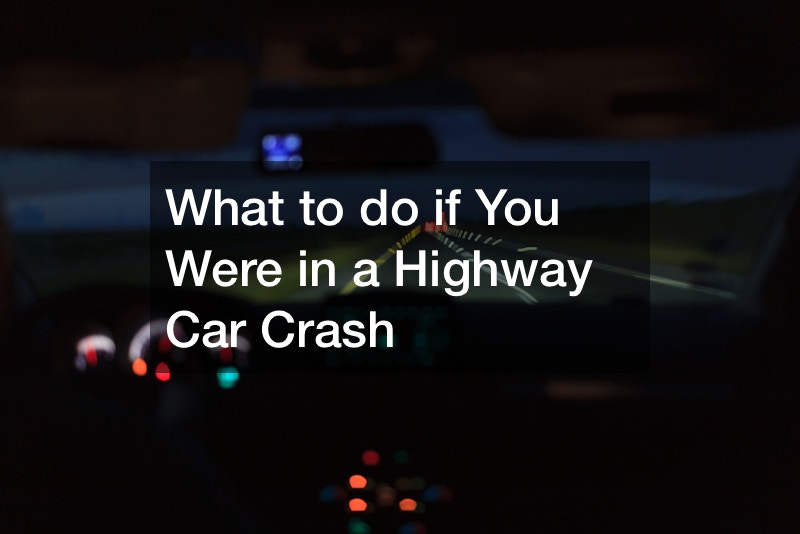What to do If You Were in a Highway Car Crash


A freeway or highway car crash involves colliding with any object while on a highway. Many assume a highway car crash is a collision between two or more vehicles. This is a wrong assumption because if a motorist drives into a lamp post, it’s considered a car crash.
Driving under the influence of an intoxicant is the main cause of car crashes in America. Intoxicants often alter a person’s state of mind, impairing their judgment. A motorist driving a car under the influence of drugs or alcohol will take longer to coordinate their limbs and react to stimuli. This is why it isn’t recommended for anyone to handle any machinery under the influence of any intoxicant.
Other causes of accidents include distracted driving, where a motorist gets consciously or sub-consciously involved in other activities that draw their mind away from concentrating while driving; overspeeding leads to many crashes too. Minor mistakes are magnified at high speeds, and reflex times are greatly reduced, denying the motorist any chance to rectify their mistake. Reckless or aggressive driving equally causes road accidents, and so does poor visibility due to bad weather or any incident that covers your eyes or windshield.
In the event of a highway car crash, your first instinct is safety and survival, in that order, regardless of your role in the accident. Update your status as soon as you regain consciousness. Scan your surroundings to establish if you’re in a good position to avoid any aftermath of an accident. Once you’re safe, check yourself for serious injuries; this is the survival part. If you’re bleeding, find a sanitary way to stop it. These are the first two steps you should take before seeking external help, which applies to motorists, passengers, and bystanders. In this article, we assume the position of a motorist involved in a highway car crash and the steps they should take.

1. Ensure Safety
Step 1: Pull over – If you’re involved in an accident where the impact didn’t break your motion, pull over to assess the incident. This decision counteracts the possibility of getting distracted from the road, potentially leading you into more trouble.
Step 2: Stop the car – In some cases, the impact may send the vehicle on a trajectory that leads to further danger. If this happens, bring the vehicle to a halt. It’s also crucial to stop the car immediately after impact so you’re the closest to the original point of contact. This helps in evidence gathering and in gaining a better understanding of the incident.
Step 3: Check for injuries – Once you’re off the road, away from further danger, check for any injuries you may have incurred during the accident. If a quick check confirms you’re good, check on the others involved in the crash. These may be passengers in your car, pedestrians, bystanders, or people in the other car. Perform first aid on them in case of injuries. If you don’t know how to perform first aid, follow the rules of thumb and cover up any bleeding wounds.
2. Understanding Your Insurance and Vehicle Options
Step 4: Protect the scene – If you’re in good shape, leave the vehicle and secure the accident scene. This is particularly important in the case of fatalities. The reason is that the relevant authorities can do their job more accurately if the accident scene has yet to be tampered with. Moving injured people from the scene may worsen their condition, and as mentioned above, it amounts to tampering with the scene. There’re exceptions to this rule, of course. If not tampering with the accident scene leads to the injury of someone or damage to property, then you can take the most appropriate action to prevent it.
Step 5: Document the accident – take pictures, videos, draw illustrations, and take notes to clarify the incident. Capture the position of everything involved in the crash, the vehicles, nearby property, and people, if there are any. Next, document the extent of damage, whether it’s those inflicted on the cars, the people involved, or the property. This evidence is helpful for your insurer, lawyer, and the police.
Step 6: Call your insurance company – Notify your auto insurer. Your insurer’s role comes into play here, and they’re typically responsible for your financial loss compensation in case of damage or the theft of your vehicle. Get covered against fiscal liability caused by a highway car crash from a trusted auto insurance company. It’s important to understand your cover, and this should be done preferably before an incident. Make the scope of your cover as wide as possible. In their language, you should be paying premiums for comprehensive coverage.
Call your insurer and give them a comprehensive account of the incident. Listen as they guide you on the way forward from there.
Step 7: Call the police to report the accident – If the perpetrator isn’t cooperative, if it’s an employers or insurers requirement, or if there are fatalities involved in the crash, you need to call the police at this point. Give them accurate information about the incident. Provide them with your exact location, the number of cars involved, the extent of injuries incurred, and the number of fatalities, if any. Listen carefully to the instructions that follow and wait for their arrival.
Step 8: Exchange contact information with the other driver(s) – The next important step is to collect the other party’s contact details and offer yours. Include their full names, license plate numbers, vehicle descriptions, insurance information, and personal contact details. This helps when providing information to your insurer or compiling your police report. Additionally, get the contact details of on-site witnesses.
Step 9: Finding fault for the car accident – At this point, you can address the cause of the accident. It may be a vehicle malfunction leading to a motorist losing control. Or it may be due to a mistake made by the other party, and if so, this is the time to engage them in conversation. Seek to agree on the cause of the accident and who was at fault. If you were the offender, own up to the accusations against you to the extent that you concur. However, even if you’re at fault, explain your case to rule out malice or recklessness.

3. Seeking Legal Guidance After an Accident
Step 10: Call a car accident lawyer – Contact your accident lawyer and inform them of the incident. Legal counsel for people in auto accidents is a specialty of car accident lawyers. They can assist you in negotiating with insurance providers, navigating the legal system, and pursuing damages and injury claims reimbursement.
Always inform your lawyer if you’re involved in a car crash, especially if you’re at fault. Involving them as early as possible puts them in a stronger position to defend you more effectively. But, even if you aren’t the offender in a highway car crash, your lawyer is still essential for negotiations with your insurer, the other party’s attorney, and the local authorities.
Local accident lawyers are usually the best attorneys to hire if you aren’t in your resident state. This is because they’re well acquainted with the local legal system and the nuanced regulations specific to your area; this is an advantage. They can offer you and your case their undivided attention and guarantee the best result for you.

4. The Role of Personal Injury Attorneys
Personal injury attorneys are a subset of litigators that offer legal counsel and representation to clients who have suffered financial loss or physical or psychological harm due to another person’s or entity’s negligence. They cover many injuries, including those caused at work or by a malfunctioning product. They guide you through the legal process, negotiate with your insurance company, gather evidence, and even represent you in court if necessary.
When hiring, pick a local personal injury attorney who can offer you individualized care, who is familiar with the local rules and regulations, know a lot about the local insurance companies, including yours, is versed in the local court system, and understands the judges. This decision will improve your chances of a positive outcome.
Employing a personal injury law firm is preferable to working with a single attorney. Personal injury legal firms have a team of attorneys, paralegals, and support personnel that frequently network with other experts to support your case. They’re better equipped to investigate and compile a compelling argument in your defense.
Step 11: Preserve Evidence – If you’re involved in a highway car crash, keep all accident-related paperwork, including medical records, correspondence with insurance, and police reports, in your road incidents file. Later, this information might be essential to the courts, police, or insurers.

5. Post-Accident Vehicle Maintenance and Replacement
Step 12: Tow your car – After an accident, if your car is damaged or rendered inoperable, it’s time to hire the services of a towing company. Depending on your type of car, get a local towing company to ferry your car to the mechanic.
To compensate for your lack of transportation, you can contact a reliable vehicle rental company and rent a suitable alternative. It’s crucial to thoroughly read the rental agreement, comprehend the insurance coverage offered by the rental firm, and, if necessary, consider extra insurance choices.
If you represent a freight company and your truck is written off, replace it by seeking used trucks for sale. This offers you a cheap option to keep your operations moving while waiting for your insurer’s compensation.
Step 13: See your doctor – It’s always advisable to visit your doctor for a check-up after a highway car crash. This is important because sometimes people tend to put the incident past them as long as they feel alright. This can be deceiving because small injuries, some invisible to the eye, may become big emergencies down the line. Seeking medical attention after a car crash takes care of your health in the long term. Liaise with your personal injury attorney for help with getting insurance and compensation for the medical financial burden that may result from treatment.
Step 14: Repair your car – After the ordeal ends, it’s time to restore your vehicle. Depending on your insurance coverage, the auto insurance company may take full responsibility for fixing your car, sometimes even getting you a new one. But, if your cover doesn’t guarantee compensation for the damage, the repairs lie squarely on you. In this case, source the parts you need to replace from a trusted wholesale auto parts dealer. Whether it’s a truck clutch replacement, headlight replacement, or a whole engine overhaul, wholesale dealers often offer the best prices.
Hire a reputable window glass replacement company to replace all your glass parts. This is preferred to having general mechanics do it since glass companies have the experience and skills for a perfect job. From little glass parts like side mirrors to windshields, acclaimed window glass companies do restoration jobs comparable to the original manufacturer. This is the quality of repairs you want for your car.
A highway car crash is a frightening, traumatizing, disorienting, and sometimes demobilizing experience. If at all avoidable, do all you can to avoid one. A simple way to do this is to drive a mechanically sound car, observe all the relevant traffic rules, avoid overspeeding, keep your concentration on the road, and never drive under the influence of any intoxicant.
It’s also essential to keep your wits with you and resist provocation by other motorists. However, because we use public roads, you can only be responsible for driving your car, but not other motorists’. The most important thing to do is try as much as possible to avoid a highway car crash, even if an oncoming car infringes traffic rules. You never know, the brakes of the oncoming car speeding towards you may have failed, and it’s now your sane duty to save the day or at least avoid getting crashed into.
Sometimes, no matter how careful you’re on the road, a highway car crash can happen to anyone. Be fully aware of the steps to take if you are involved in a highway car crash. Follow the steps above, from pulling over after an accident, securing yourself, taking care of others, reporting the accident to the authorities, documenting the accident scene, to repairing your car, among other critical steps enumerated above.


